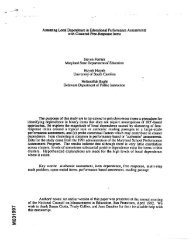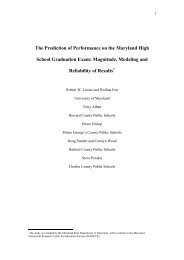A Brief Introduction to Evidence-Centered Design CSE Report 632 ...
A Brief Introduction to Evidence-Centered Design CSE Report 632 ...
A Brief Introduction to Evidence-Centered Design CSE Report 632 ...
Create successful ePaper yourself
Turn your PDF publications into a flip-book with our unique Google optimized e-Paper software.
models, this primer places such models in<strong>to</strong> the context of assessment process. Itwill serve <strong>to</strong> motivate, we hope, and <strong>to</strong> lay the groundwork for more technicaldiscussions of the framework and applications of it.In accordance with the goal, most attention is focused on models called theConceptual Assessment Framework, or CAF, and the Four-Process Architecture forassessment delivery systems. The reader interested in a fuller treatment of ECD isreferred <strong>to</strong> Mislevy, Steinberg, and Almond (2003), for connections <strong>to</strong> thephilosophy of argument and discussions of the earlier stages of design, and <strong>to</strong>Almond, Steinberg, and Mislevy (2002) for amplification on delivery systemarchitecture.The first section provides a rationale for assessment as a special case of anexercise in evidentiary reasoning, with validity as the grounds for the inferencesdrawn from assessment data (Cronbach, 1989; Embretson, 1983; Kane, 1992; andMessick 1989, 1994). ECD provides a structural framework for parsing anddeveloping assessments from this perspective. A brief overview of the CAF andFour-Process Architecture delivery are presented.As running illustrations, we will use examples based on the paper and pencil(P&P) and the computer adaptive (CAT) versions of the Graduate RecordExamination (GRE), and from a pro<strong>to</strong>type of a computer-based assessment ofproficiency in dental hygiene (Mislevy, Steinberg, Breyer, Almond, & Johnson, 1999,2002), developed by Educational Testing Service and the Chauncey GroupInternational for the Dental Interactive Simulations Corporation (DISC). As this iswritten, the GRE is comprised of three domains of items, concerning Verbal,Quantitative, and Analytic reasoning skills. In each case, a student responds <strong>to</strong> anumber of items in the domain, and an estimate of a single proficiency with regard<strong>to</strong> that domain is reported. The DISC pro<strong>to</strong>type concerns seven aspects of knowledgeand skill, and evidence is gathered as the student works through scenarios based o nthe examination and treatment of simulation patients.Assessment as Evidentiary ArgumentAdvances in cognitive psychology deepen our understanding of how studentsgain and use knowledge. Advances in technology make it possible <strong>to</strong> capture morecomplex performances in assessment settings by including, for example, simulation,interactivity, collaboration, and constructed response. Au<strong>to</strong>mated methods have3






